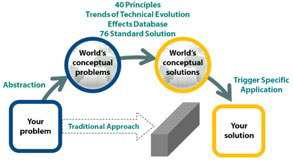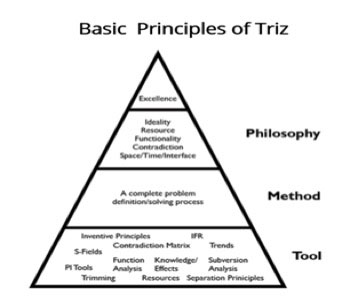
TRIZ IS A BEST KEPT SECRET
TRIZ is an advanced and powerful multidimensional methodology of the “Theory of Inventive Problem Solving.” Only recently has it been exposed to technology-driven businesses. TRIZ has the potential to easily match the impact that CAD systems had on new product design. TRIZ draws on many scientific principles such as physics, chemistry, geometry, mathematics, and computer science.
TRIZ tells us that the nuclear, aerospace, bio-sciences, micro-electronics, chemistry, automotive, education, politics, logistics and other sectors are all solving similar problems and it is very conceivable that someone has already solved virtually the same problem. The main success factor for this form of “Systematic Innovation,” is to get some initial tangible benefit from predicting solutions for problems yet unrecognized!
THREE FUNDAMENTALS OF TRIZ
Problems and solutions are repeated across industries and sciences.
Patterns of technical evolution are also repeated across industries and science.
The innovation approach uses scientific effects outside the field in which they are developed.
TRIZ is the outcome of extensive research into patents, scientific journals, engineering, university papers, and business data resources. This process of fundamental, logical thinking can solve complex problems, find the next generation of technology (called Directed Evolution) and assist in protecting existing patents (called Patent Fencing).

TRIZ algorithm have been developed to solve technical problems that occur in existing techniques or new technical systems. In essence, you have access to millions of past clever thinkers and genius problem-solvers in all areas of science, engineering, and technology and need only reapply what they’re already learned.
When TRIZ Shoud Be Used
• Challenging problem (not solved for years)
• Need “out of the box” solution
• Cost reduction or major improvement
• Not a compromise or Trade-off Majo
• All solutions have been searched
• Intuition, past experience, trial/error didn’t work
• Need an Optimal and “ideal solution”
• Need deep system analysis
• Each solution creates new one
• Need to build a “Solution Bank”
UNIVERSITIES AND COMPANIES DISCOVERED TRIZ
There is a long list of Colleges and Research Centers who rely on TRIZ principles and software to teach tomorrow’s scholars and a long list of growth companies that give data scientists and engineers powerful tools and competitive advantages for leading research and product development.

Universities teaching TRIZ: Carnegie Mellon, University of Michigan, Rice University, University of Southern California, Texas Tech, University of South Carolina, Vanderbilt, and University of Texas. TRIZ is part of the curriculum within classes in computer science, mechanical engineering, bio-science and other majors.
Research Centers using TRIZ: NASA, JPL, U.S. Air Force, US Army War College, are only a few of the important “think tanks” that rely and integrate TRIZ into their data evaluation systems.
Major Technology firms that utilize the benefits of TRIZ : Hewlett-Packard, Ford, Shell, 3M, Procter & Gamble, Johnson & Johnson, Honeywell, United Technologies, Whirlpool, and Lockheed Martin, among many others.
Cases studies on the use of TRIZ are difficult to acquire because companies have a competitive advantage and do not want to publicize of methods used. Samsung is the most famous success story; their engineers and product developers are required to learn TRIZ, right up to and including the CEO.
SUMMARY
This large leap forward can come from breakthrough products and create new customer behavior.
The foundation of TRIZ is knowledge-based innovation and TRIZ embodies an extensive data base of innovative concepts extracted from the study of millions of patents, scientific discoveries, and research data bases. TRIZ views innovation as problem-solving tools and contradictions are the problems.
Technology innovation is critical for attaining and maintaining a competitive advantage. Like any other science, TRIZ can be developed in one of two directions: empirical way of observing, abstracting, and formulating hypotheses, and guidelines OR postulating a set of axioms, proving theorems, modeling and formulating a theory. So, far most of TRIZ direction has been empirical.
Learn more about our Innovation Lab Tools
